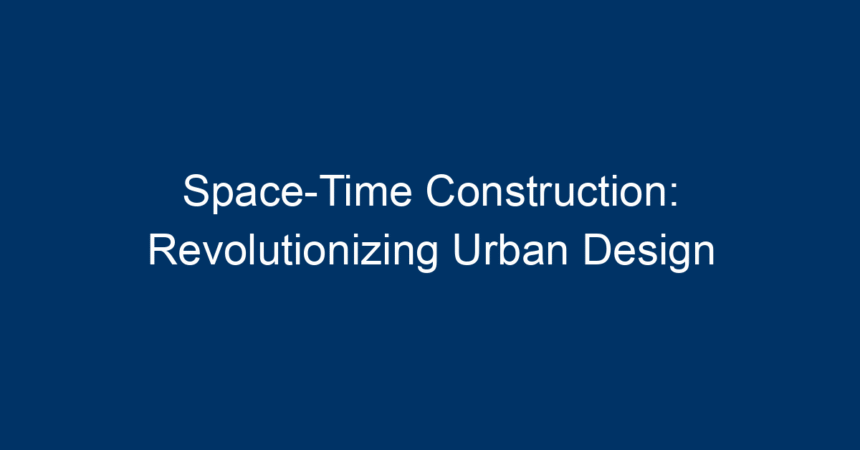In the rapid evolution of urban landscapes, the concept of space-time construction has emerged as a transformative force, fundamentally reshaping how cities are designed, built, and experienced. This innovative approach marries architectural design, engineering, and advanced technology, allowing for more efficient utilization of space and time. As urban areas continue to expand and diversify, understanding and implementing space-time construction principles has become not just beneficial, but necessary for sustainable urban development.
What is Space-Time Construction?
Space-time construction refers to a design philosophy that emphasizes the relationship between physical space and temporal experiences in urban settings. Rather than viewing buildings and public spaces as static entities, this approach considers how these environments function dynamically over time. This concept embraces adaptability, mobility, and temporality, allowing urban environments to respond to the needs of their inhabitants effectively.
The Need for Innovative Urban Design
With urban populations projected to reach over 68% globally by 2050, the demand for innovative urban design solutions has never been more critical. Traditional construction methods often fall short in addressing the complexities of modern urban living. Issues such as space scarcity, environmental concerns, and social equity pose significant challenges. Space-time construction seeks to remedy these flaws by introducing flexible and resilient design frameworks that can evolve, thus ensuring that urban designs remain relevant over time.
Key Principles of Space-Time Construction
1. Flexibility and Adaptability
One of the cornerstones of space-time construction is flexibility. Buildings and public spaces designed under this philosophy can adapt to various uses and activities over time. For instance, modular construction allows for quick reconfiguration of spaces, enabling them to serve multiple purposes. This adaptability means that urban areas can respond to changing demographics and social needs without requiring extensive renovation resources.
2. Integration of Technology
The integration of technology into space-time construction practices is a game changer. Smart technologies and data analytics can monitor how spaces are used, allowing for informed decision-making regarding adjustments and improvements. Panels equipped with sensors can gather data on foot traffic, environmental conditions, and user preferences, feeding this information back to planners and architects for continuous enhancement.
3. Sustainability
Space-time construction is inherently linked to sustainable development. By optimizing the use of existing spaces and minimizing the need for new constructions, cities can reduce resource consumption and limit their carbon footprint. Incorporating green building technologies, such as solar panels and rainwater harvesting systems, further contributes to this sustainability goal.
4. Community-Centric Design
At the heart of space-time construction is a strong emphasis on the community. Engaging local residents in the design process ensures that developments reflect the needs and desires of those who will use them. This participatory approach creates a sense of ownership and belonging among inhabitants, fostering vibrant and inclusive urban environments.
Applications of Space-Time Construction in Urban Design
1. Multi-Use Developments
Utilizing principles of space-time construction, cities can create multi-use developments that serve various functions throughout the day. For instance, a building can house a café during the day, transforming into an event space in the evening. This not only maximizes space utilization but also curates a lively urban atmosphere that encourages social interaction.
2. Smart Urban Mobility Solutions
Smart mobility solutions are integral to space-time construction. Integrating public transport, pedestrian pathways, and cycling routes creates a cohesive transportation framework. Real-time data provides insights into traffic patterns, enabling efficient resource allocation and helping to reduce congestion. This interconnectedness enhances the urban experience while promoting environmentally friendly travel options.
3. Temporary Urban Interventions
Temporary installations and pop-up spaces exemplify the dynamic nature of space-time construction. These interventions can adapt to seasonal events, festivals, or markets, enriching the urban fabric. They allow cities to experiment with new concepts without the long-term commitment of permanent structures, fostering innovation and community engagement.
4. Green Spaces
Urban green spaces are essential for quality of life in cities. Through space-time construction, parks and recreational areas can offer versatile experiences. For instance, a park might feature an outdoor cinema during summer nights, transforming into a community gardening space by day. The interaction of time and space maximizes the ecological and emotional benefits of these areas.
Challenges in Implementing Space-Time Construction
Despite the promising potential of space-time construction, several challenges must be addressed:
1. Funding and Investment
Many space-time construction projects demand significant initial investment. Gaining stakeholder buy-in, including governmental support and private funding, can be daunting. However, effectively communicating the long-term benefits of adaptive and sustainable urban environments can garner necessary financial backing.
2. Regulatory Frameworks
Current building codes and zoning laws may not readily accommodate innovative construction methods. Urban planners must advocate for more flexible regulations to support the principles of space-time construction, enabling developers to implement transformative projects.
3. Public Perception and Understanding
There might be skepticism about the feasibility of space-time construction among the public and decision-makers. Promoting successful case studies and increasing awareness of the potential benefits can help shift perceptions and encourage wider acceptance.
Case Studies: Successful Examples of Space-Time Construction
Barcelona, Spain
Barcelona has implemented various space-time concepts in its urban design, particularly through the MEG (Superblock) initiative, which restricts vehicular access in certain areas to promote pedestrian movement. These superblocks are reconfigured regularly to host community events, encourage local businesses, and improve urban air quality, embodying the principles of flexible and adaptive urban design.
Amsterdam, Netherlands
Amsterdam’s approach to managing its historic canals demonstrates space-time construction principles. The city uses its waterways for both transportation and leisure, with plans for adaptable floating housing that changes with the water levels. This flexibility not only provides housing in a constrained space but actively addresses environmental concerns.
Conclusion: Moving Forward with Space-Time Construction
As urban environments continue to grow, embracing space-time construction offers significant advantages in creating dynamic, sustainable, and community-centered cities. By prioritizing flexibility, technological integration, and public engagement, urban designers and planners can create environments that adapt to the evolving needs of their inhabitants.
Moving forward, stakeholders at all levels must commit to fostering awareness and supporting initiatives that incorporate space-time principles. Engaging with local communities, leveraging technology, and pushing for progressive policy changes will be crucial in transforming urban design for the better.
In this era of rapid urbanization, the potential of space-time construction is limitless—let’s harness it for a brighter urban future.




